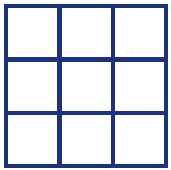This problem solving activity has a number focus.
Tui is getting the idea of magic squares.
She decides to make all of the magic squares that she can using the numbers –2, 4 and 10 down the main diagonal.
How many can she make?
It takes her quite a while because she doesn’t know that the sum of a magic square is always three times the number in the centre.
- Perform addition with negative numbers.
- Know the idea of, and be able to construct, magic squares.
- Devise and use problem solving strategies to explore situations mathematically (be systematic).
A magic square is an arrangement like the one below where the vertical, horizontal and diagonal lines of numbers all add up to the same value. This ‘same value’ is called the sum of the magic square.
| 4 | 1 | 7 |
| 7 | 4 | 1 |
| 1 | 7 | 4 |
It’s a critical part of this problem that three times the centre square is equal to the sum of the magic square.
Magic squares are interesting objects in both mathematics proper and in recreational mathematics. It is likely that students have already encountered magic squares. The problems in this sequence give students the opportunity to use known numerical or algebraic concepts, and apply their knowledge of negative numbers.
This problem is part of a series of Number problems exploring magic squares. Little Magic Squares and A Square of Circles, Level 2; Big Magic Squares, Level 3; and Fractional Magic Squares, Level 4. The Magic Square, Level 5 shows why three times the centre number is equal to the sum of the magic square. Difference Magic Squares, Level 6, looks at an interesting variation of the magic square concept.
The Problem
Tui is getting the idea of magic squares. She decides to make all of the magic squares that she can using the numbers –2, 4 and 10 down the main diagonal. How many can she make?
It takes her quite a while because she doesn’t know that the sum of a magic square is always three times the number in the centre.
Teaching Sequence
- Show the students a magic square such as the one below, and ask why it is called a magic square.
| 6 | 1 | 5 |
| 3 | 4 | 5 |
| 3 | 7 | 2 |
- Have them to check that the rows all have the same sum (of 12); that the columns all have the same sum; and that the diagonals have the same sum.
- Pose Tui’s problem.
- Have them work in pairs to see how many magic squares they can find.
It is probable that they will begin to see that there are an infinite number of magic squares. They may think that for every different number you put in the middle top row entry, you get a different magic square. But this isn’t quite correct. It is true though that two numbers that add to 20 give the same magic square. However this still gives an infinite number. - Get some of the pairs to report back. Can they prove that the arrays they have produced are magic squares? How many do they think there are?
- Ask the students to write up what they have discovered.
- Pose the extension problem when appropriate. Those that can work with algebraic expressions might like to try the second part of the extension.
Extension
Can you make up a magic square that has negative and positive numbers in it?
Can you show that the sum of a magic square is three times the centre entry?
Solution
Expect the students at this level to begin to work systematically. After putting in the main diagonal of –2, 4 and 10, they should experiment with different numbers in the centre top row position. We have tried 6, 8, -6 and –8 below. Remember that the sum is always 12. (Why?)
|
|
|
|
Now if we try a little algebra here we can see that there are an infinite number of these magic squares. Suppose that that centre top entry is h. Then the other entries are forced. If h is replaced by 20-h, then we get the same square. So every positive integer value over 20 gives a new magic square. There are therefore an infinite number of them.
|
|
|
|
Solution to the Extension
But why is the sum of a magic square three times the centre number? Look at the magic square below, where all the entries are replaced by letters
| a | b | c |
| d | e | f |
| g | h | i |
Think about all of the rows, columns and diagonals through the centre square. So, if s is the sum, then
a + e + i = s
b + e + h = s
c + e + g = s
d + e + f = s
Add all of these up and you’ll get
(a + d + g) + (b + e + h) + (c + f + i) + 3e = 4s.
Now each term in the brackets equals s as they are the column sums. So
s + s + s + 3e = 4s.
This means that 3e = s just as we have told you all along!
